Individually prepare a discounted cash flow analysis for the two alternative projects; Design Your Own Doll and Match My Doll Clothing base on the Excel valuation that you completed last week. Evaluate the projects based on net present value, internal rate of return, and payback period Consider these results along with other strategic points made in the case and analyze the situation. Discuss the pros and cons of each project make and discuss your recommendation on which, if any, project to choose.
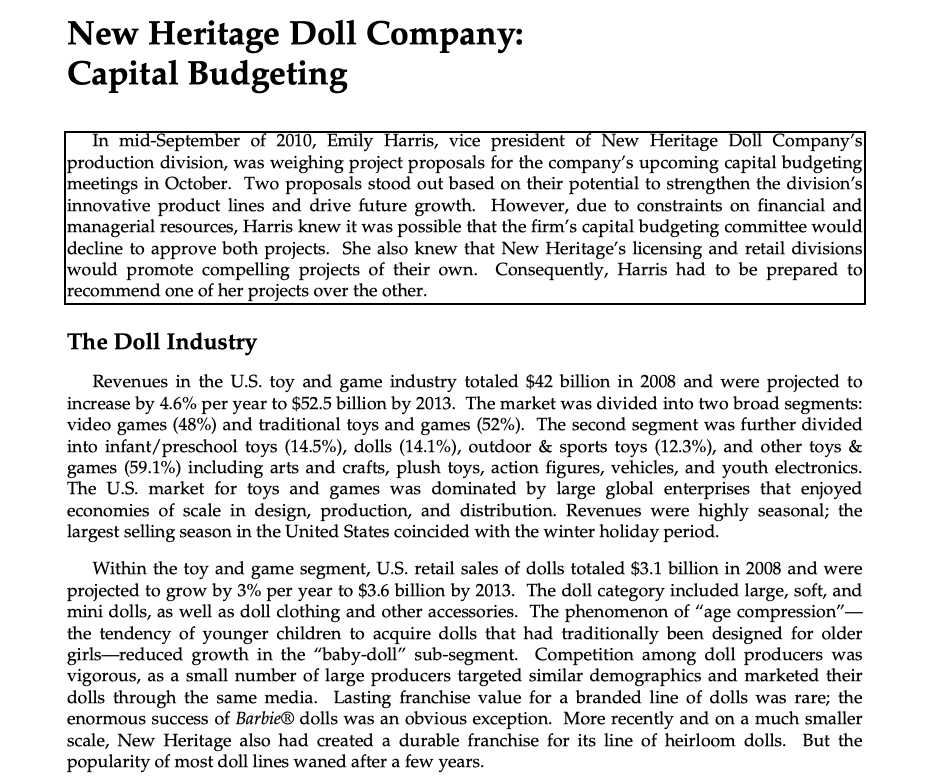
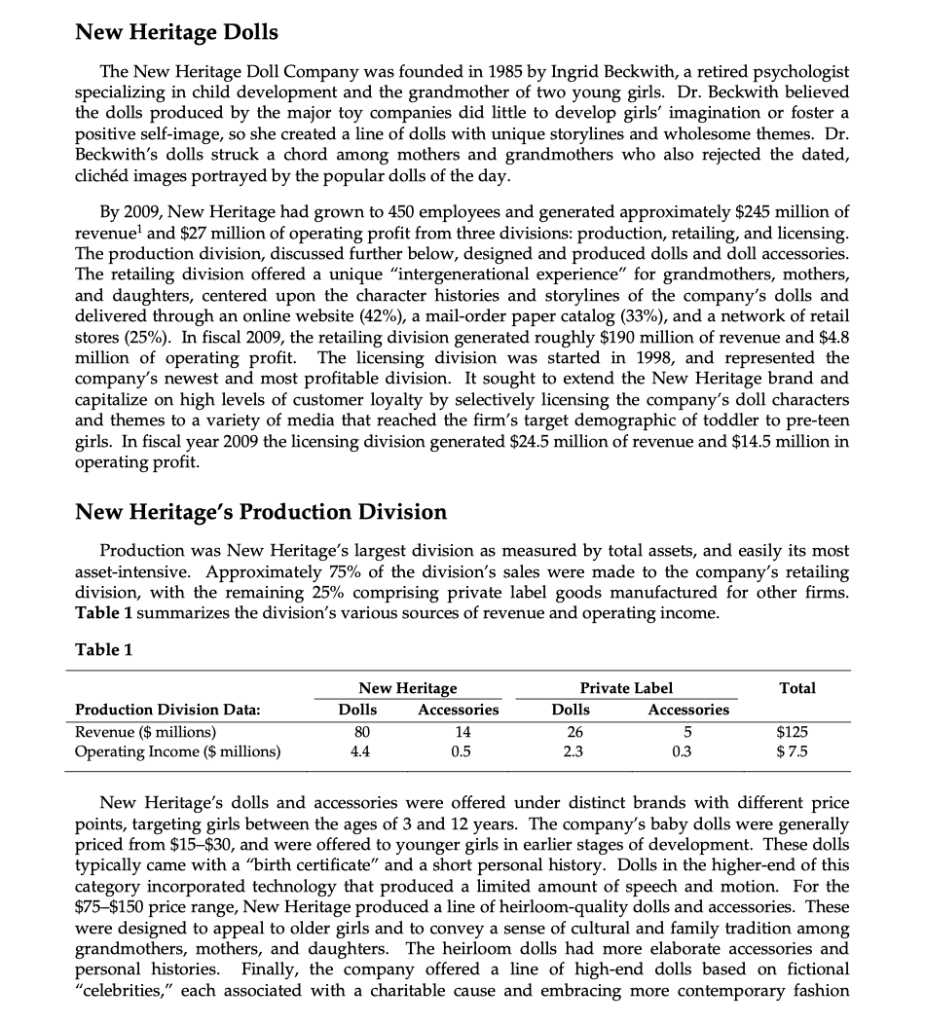
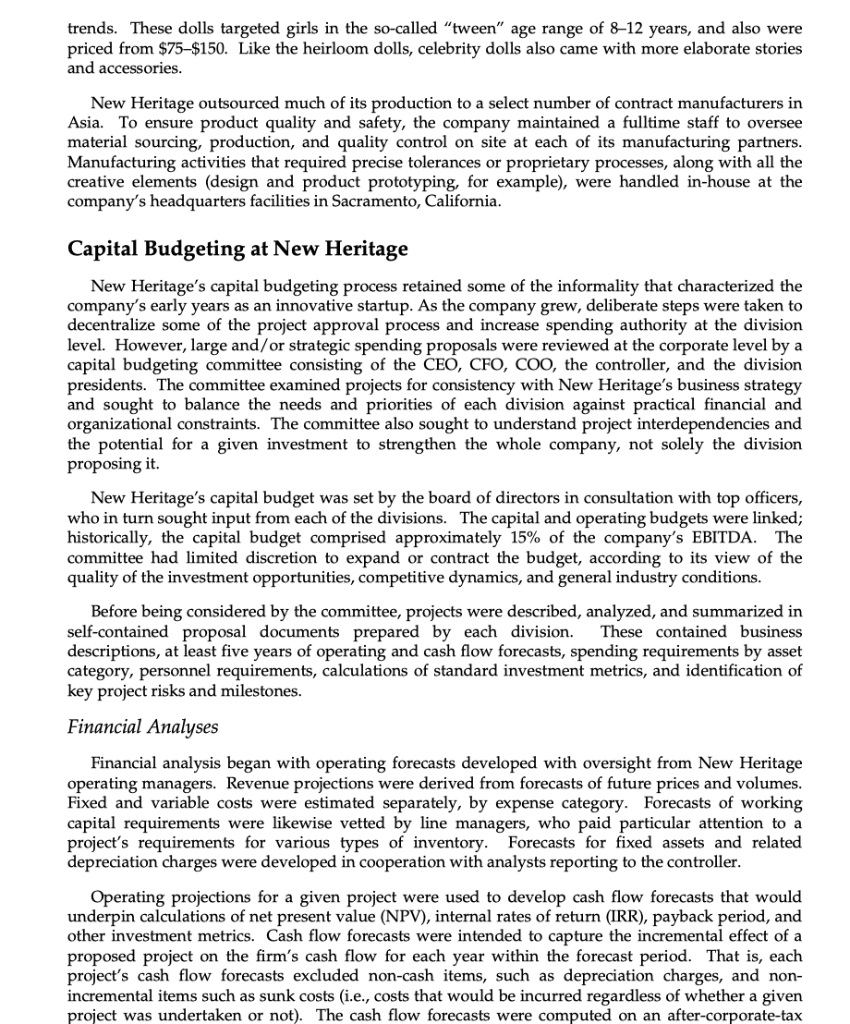
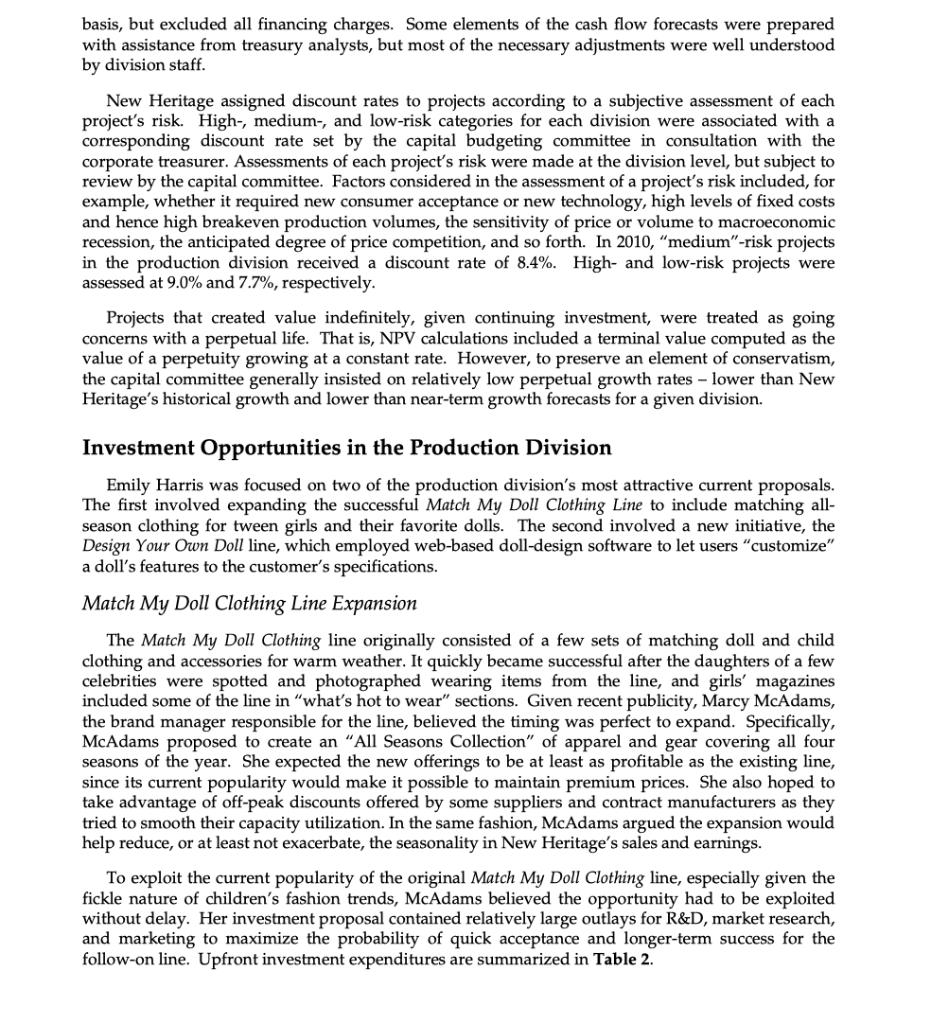
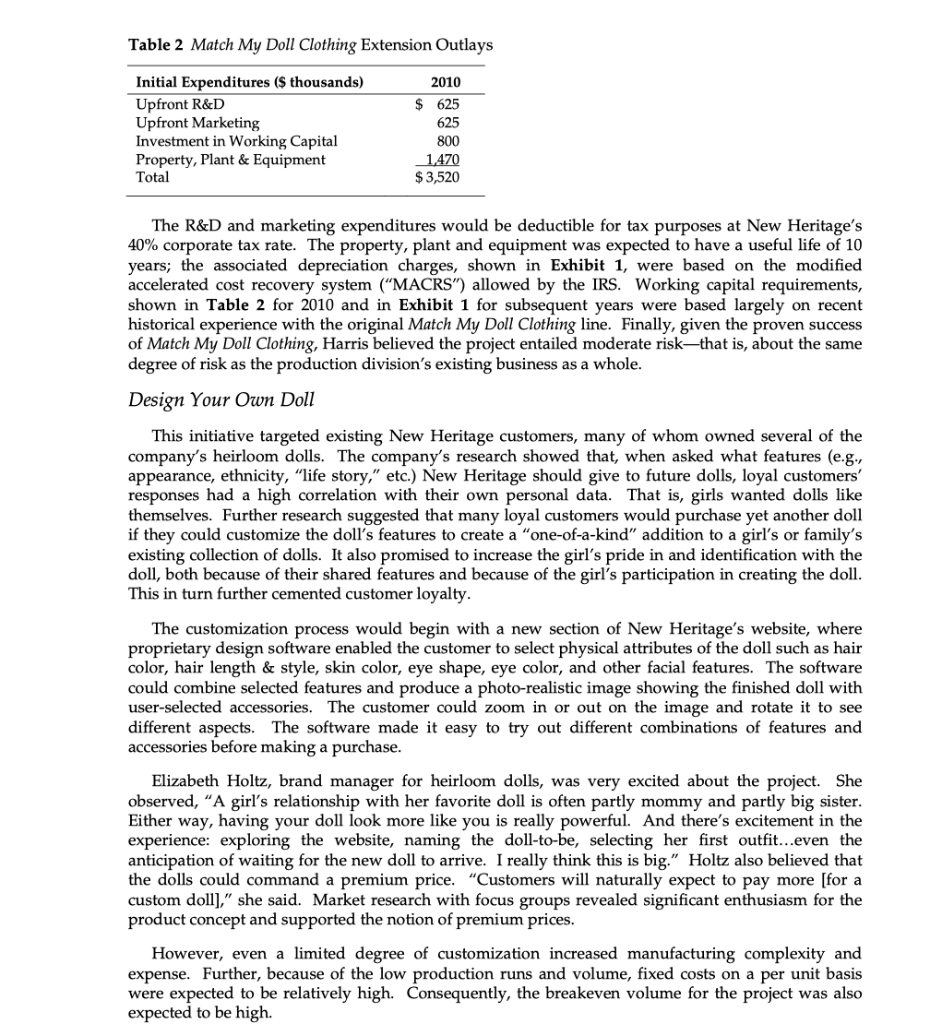
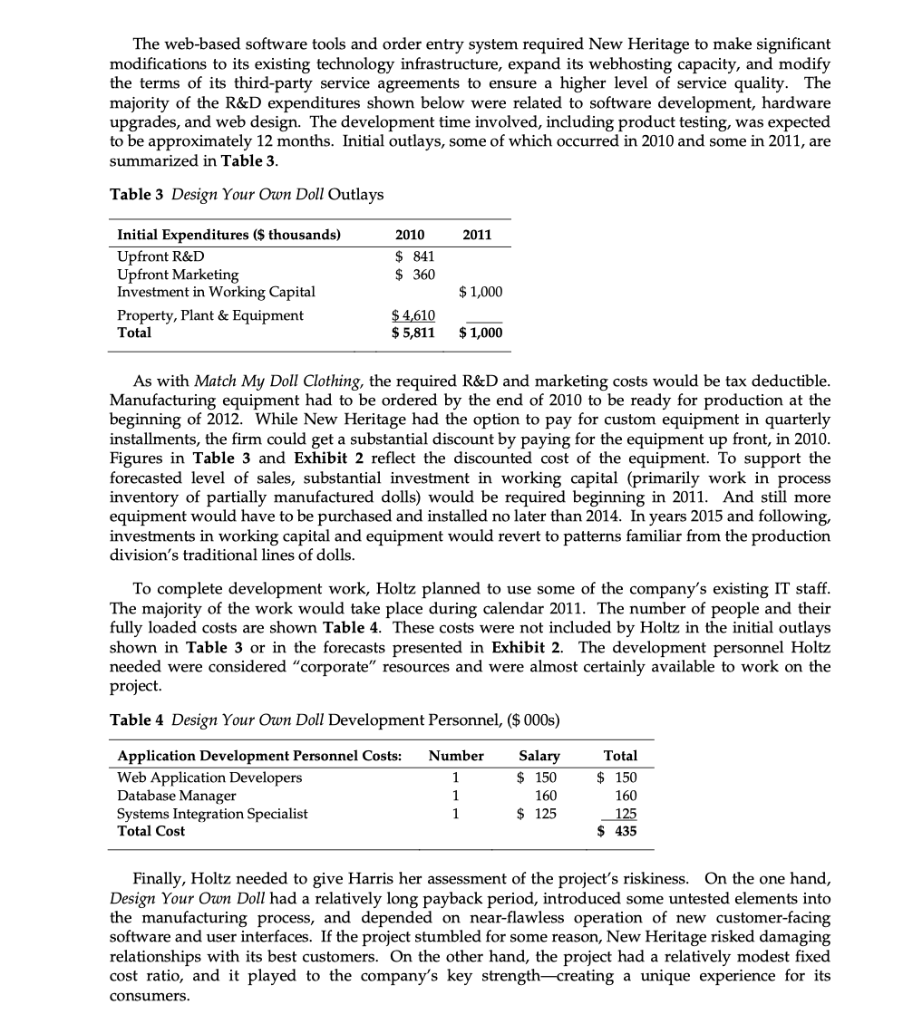
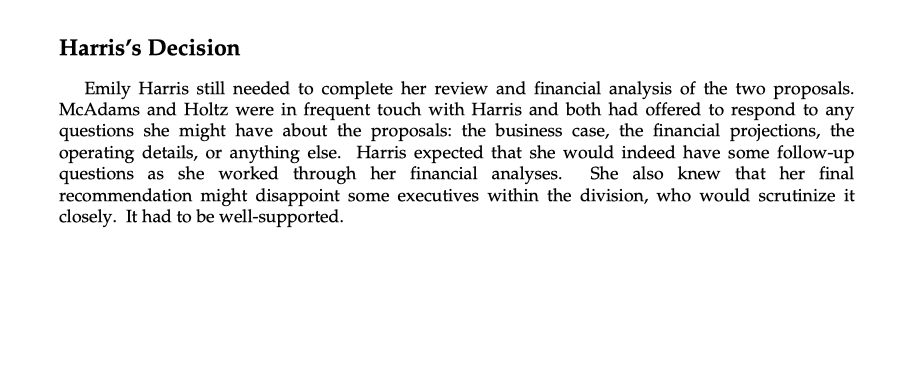
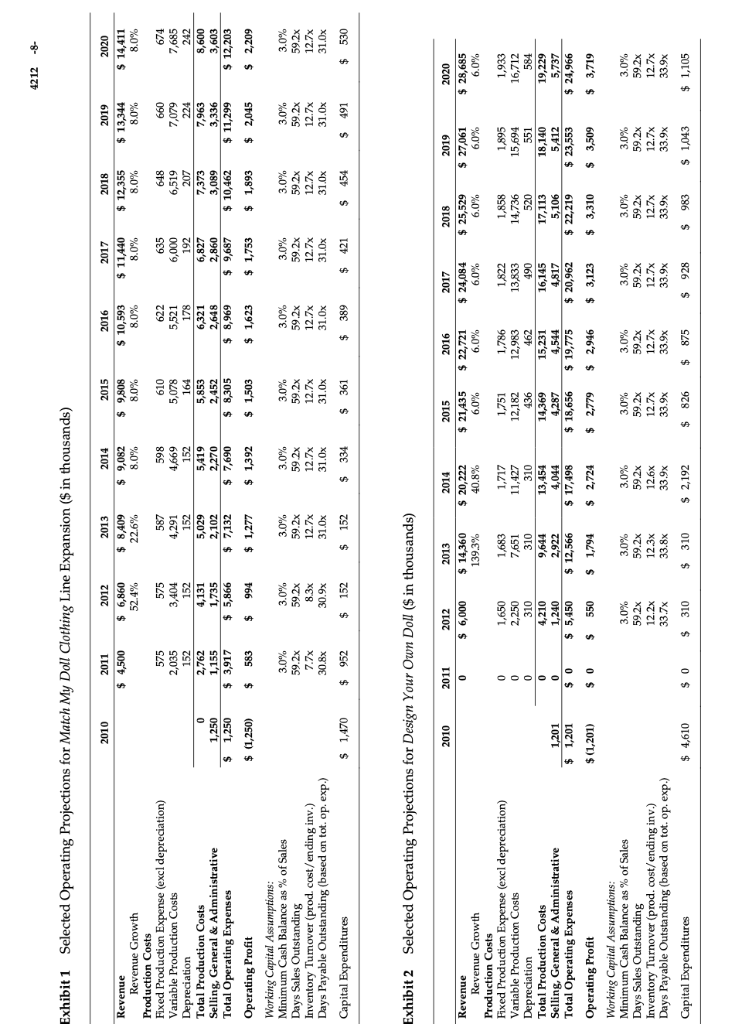
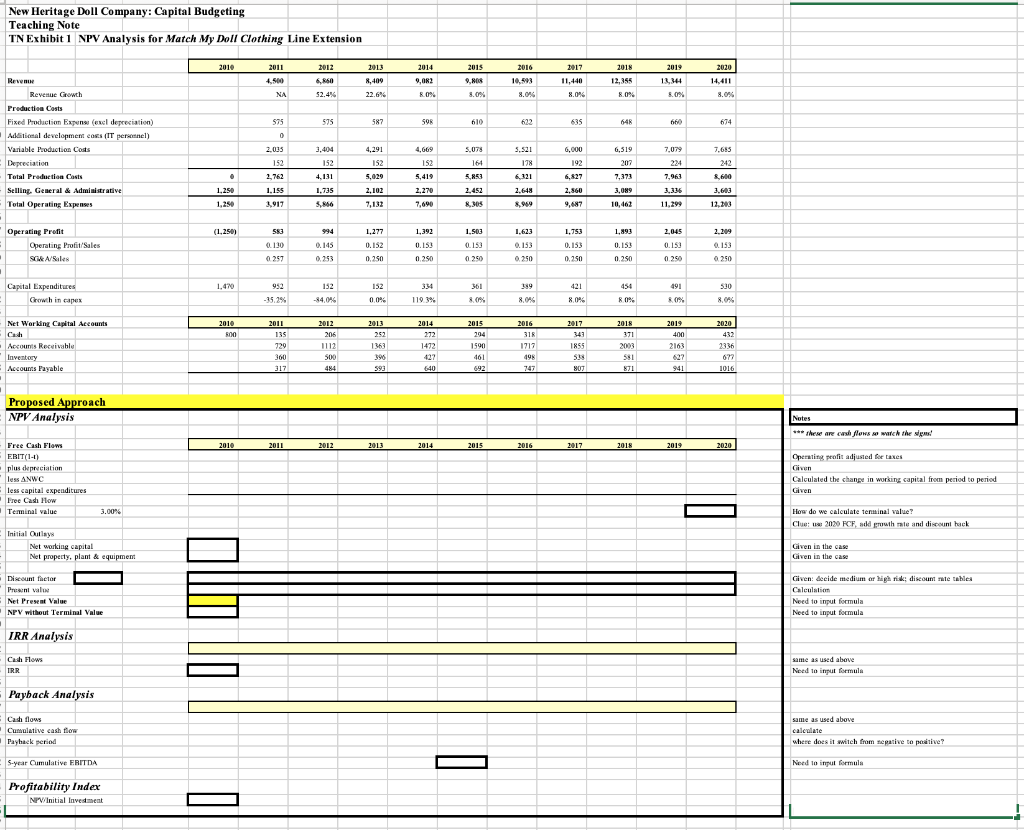
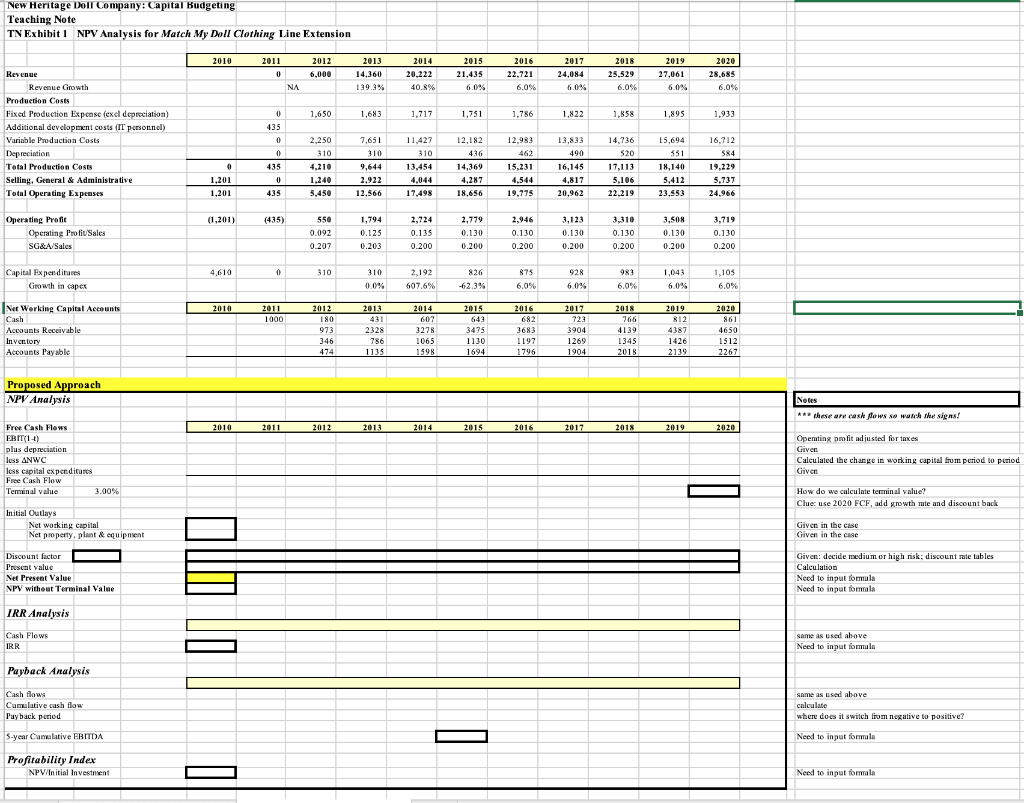
New Heritage Doll Company: Capital Budgeting In mid-September of 2010, Emily Harris, vice president of New Heritage Doll Company's production division, meetings in October. Two proposals stood out based on their potential to strengthen the division's innovative product lines and drive future growth. However, due to constraints on financial and managerial resources, Harris knew it was possible that the firm's capital budgeting committee would decline to approve both projects. She also knew that New Heritage's licensing and retail divisions would promote compelling projects of their own recommend one of her projects over the other weighing project proposals for the company's upcoming capital budgeting was Consequently, Harris had to be prepared to The Doll Industry Revenues in the U.S. toy and game industry totaled $42 billion in 2008 and were projected to increase by 4.6% per year to $52.5 billion by 2013. The market was divided into two broad segments: video games (48%) and traditional toys and games (52%). The second segment was further divided into infant/preschool toys (14.5%), dolls (14.1%), outdoor & sports toys (12.3%), and other toys & games (59.1%) including arts and crafts, plush toys, action figures, vehicles, and youth electronics The U.S. market for toys and games was dominated by large global enterprises that enjoyed economies of scale in design, production, and distribution. Revenues were highly seasonal; the largest selling season in the United States coincided with the winter holiday period. Within the toy and game segment, U.S. retail sales of dolls totaled $3.1 billion in 2008 and were projected to grow by 3% per year to $3.6 billion by 2013. The doll category included large, soft, and mini dolls, as well as doll clothing and other accessories. The phenomenon of "age compression"- the tendency of younger children to acquire dolls that had traditionally been designed for older girls-reduced growth in the "baby-doll" sub-segment. Competition among doll producers was vigorous, a dolls through the same media. Lasting franchise value for a branded line of dolls was rare; the enormous success of Barbie dolls was an obvious exception. More recently and on a much smaller scale, New Heritage also had created a durable franchise for its line of heirloom dolls. But the popularity of most doll lines waned after a few years. small number of large producers targeted similar demographics and marketed their New Heritage Dolls The New Heritage Doll Company was founded in 1985 by Ingrid Beckwith, a retired psychologist specializing in child development and the grandmother of two young girls. Dr. Beckwith believed the dolls produced by the major toy companies did little to develop girls' imagination or foster a positive self-image, so she created a line of dolls with unique storylines and wholesome themes. Dr. Beckwith's dolls struck a chord among mothers and grandmothers who also rejected the dated, clichd images portrayed by the popular dolls of the day By 2009, New Heritage had grown to 450 employees and generated approximately $245 million of revenue and $27 million of operating profit from three divisions: production, retailing, and licensing The production division, discussed further below, designed and produced dolls and doll accessories The retailing division offered a unique "intergenerational experience" for grandmothers, mothers, and daughters, centered upon the character histories and storylines of the company's dolls and delivered through an online website (42%), a mail-order paper catalog (33%), and a network of retail stores (25%). In fiscal 2009, the retailing division generated roughly $190 million of revenue and $4.8 million of operating profit. The licensing division was started in 1998, and represented the company's newest and most profitable division. It sought to extend the New Heritage brand and capitalize on high levels of customer loyalty by selectively licensing the company's doll characters and themes to a variety of media that reached the firm's target demographic of toddler to pre-teen girls. In fiscal year 2009 the licensing division generated $24.5 million of revenue and $14.5 million in operating profit New Heritage's Production Division Production was New Heritage's largest division as measured by total assets, and easily its most asset-intensive. Approximately 75% of the division's sales were made to the company's retailing division, with the remaining 25% comprising private label goods manufactured for other firms. Table 1 summarizes the division's various sources of revenue and operating income Table 1 New Heritage Private Label Total Production Division Data: Dolls Accessories Dolls Accessories Revenue ($ millions) Operating Income ($ millions) 80 $125 $7.5 14 26 5 4.4 0.5 2.3 0.3 New Heritage's dolls and accessories were offered under distinct brands with different price points, targeting girls between the ages of 3 and 12 years. The company's baby dolls were generally priced from $15-$30, and were offered to younger girls in earlier stages of development. These dolls typically category incorporated technology that produced a limited amount of speech and motion. For the $75-$150 price range, New Heritage produced a line of heirloom-quality dolls and accessories. These were designed to appeal to older girls and to convey a sense of cultural and family tradition among grandmothers, mothers, and daughters. The heirloom dolls had more elaborate accessories and personal histories. Finally, the company offered a line of high-end dolls based orn fictional "celebrities," each associated with a charitable cause and embracing more contemporary fashion came with a "birth certificate" and a short personal history. Dolls in the higher-end of this trends. These dolls targeted girls in the so-called "tween" age range of 8-12 years, and also were priced from $75-$150. Like the heirloom dolls, celebrity dolls also came with more elaborate stories and accessories New Heritage outsourced much of its production to a select number of contract manufacturers in Asia. To ensure product quality and safety, the company maintained a fulltime staff to oversee material sourcing, production, and quality control on site at each of its manufacturing partners. Manufacturing activities that required precise tolerances or proprietary processes, along with all the creative elements (design and product prototyping, for example), were handled in-house at the company's headquarters facilities in Sacramento, California. Capital Budgeting at New Heritage New Heritage's capital budgeting process retained some of the informality that characterized the company's early years as an innovative startup. As the company grew, deliberate steps were taken to decentralize some of the project approval process and increase spending authority at the division level. However, large and/or strategic spending proposals were reviewed at the corporate level by a capital budgeting committee consisting of the CEO, CFO, COO, the controller, and the division presidents. The committee examined projects for consistency with New Heritage's business strategy and sought to balance the needs and priorities of each division against practical financial and organizational constraints. The committee also sought to understand project interdependencies and the potential for a proposing it given investment to strengthen the whole company, not solely the division New Heritage's capital budget was set by the board of directors in consultation with top officers, who in turn sought input from each of the divisions. The capital and operating budgets were linked; historically, the capital budget comprised approximately 15% of the company's EBITDA committee had limited discretion to expand or contract the budget, according to its view of the quality of the investment opportunities, competitive dynamics, and general industry conditions The Before being considered by the committee, projects were described, analyzed, and summarized in self-contained proposal documents prepared by each division. descriptions, at least five years of operating and cash flow forecasts, spending requirements by asset category, personnel requirements, calculations of standard investment metrics, and identification of key project risks and milestones. These contained business Financial Analyses Financial analysis began with operating forecasts developed with oversight from New Heritage operating managers. Revenue projections were derived from forecasts of future prices and volumes. Fixed and variable costs were estimated separately, by expense category. Forecasts of working capital requirements were likewise vetted by line managers, who paid particular attention to a project's requirements for various types of inventory. depreciation charges were developed in cooperation with analysts reporting to the controller. Forecasts for fixed assets and related Operating projections for a given project were used to develop cash flow forecasts that would underpin calculations of net present value (NPV), internal rates of return (IRR), payback period, and other investment metrics. Cash flow forecasts were intended to capture the incremental effect of a proposed project on the firm's cash flow for each year within the forecast period. That is, each project's cash flow forecasts excluded non-cash items, such as depreciation charges, and non- incremental items such as sunk costs (i.e., costs that would be incurred regardless of whether a given project was undertaken or not). The cash flow forecasts were computed on an after-corporate-tax basis, but excluded all financing charges. Some elements of the cash flow forecasts were prepared with assistance from treasury analysts, but most of the necessary adjustments were well understood by division staff. subjective assessment of each New Heritage assigned discount rates to projects according project's risk. High-, medium-, and low-risk categories for each division were associated with a corresponding discount rate set by the capital budgeting committee in consultation with the corporate treasurer. Assessments of each project's risk were made at the division level, but subject to review by the capital committee. Factors considered in the assessment of a project's risk included, for example, whether it required new consumer acceptance or new technology, high levels of fixed costs and hence high breakeven production volumes, the sensitivity of price or volume to macroeconomic recession, the anticipated degree of price competition, and so forth. In 2010, "medium"-risk projects in the production division received a discount rate of 8.4%. High- and low-risk projects were assessed at 9.0% and 7.7%, respectively. to a Projects that created value indefinitely, given continuing investment, were treated as going concerns with a perpetual life. That is, NPV calculations included a terminal value computed as the value of a perpetuity growing at a constant rate. However, to preserve an element of conservatism, the capital committee generally insisted on relatively low perpetual growth rates - lower than New Heritage's historical growth and lower than near-term growth forecasts for a given division Investment Opportunities in the Production Division Emily Harris was focused on two of the production division's most attractive current proposals. The first involved expanding the successful Match My Doll Clothing Line to include matching all- season clothing for tween girls and their favorite dolls. The second involved a new initiative, the Design Your Own Doll line, which employed web-based doll-design software to let users "customize" a doll's features to the customer's specifications Match My Doll Clothing Line Expansion The Match My Doll Clothing line originally consisted of a few sets of matching doll and child clothing and accessories for warm weather. It quickly became successful after the daughters of a few celebrities were spotted and photographed wearing items from the line, and girls' magazines included some of the line in "what's hot to wear" sections. Given recent publicity, Marcy McAdams, the brand manager responsible for the line, believed the timing was perfect to expand. Specifically, McAdams proposed to create an "All Seasons Collection" of apparel and gear covering all four seasons of the year. She expected the new offerings to be at least as profitable as the existing line, since its current popularity would make it possible to maintain premium prices. She also hoped to take advantage of off-peak discounts offered by some suppliers and contract manufacturers as they tried to smooth their capacity utilization. In the same fashion, McAdams argued the expansion would help reduce, or at least not exacerbate, the seasonality in New Heritage's sales and earnings. To exploit the current popularity of the original Match My Doll Clothing line, especially given the fickle nature of children's fashion trends, McAdams believed the opportunity had to be exploited without delay. Her investment proposal contained relatively large outlays for R&D, market research, and marketing to maximize the probability of quick acceptance and longer-term success for the follow-on line. Upfront investment expenditures are summarized in Table 2. Table 2 Match My Doll Clothing Extension Outlays Initial Expenditures ($ thousands) Upfront R&D Upfront Marketing Investment in Working Capital Property, Plant & Equipment Total 2010 $ 625 625 800 1,470 $3,520 The R&D and marketing expenditures would be deductible for tax purposes at New Heritage's 40% corporate tax rate. The property, plant and equipment was expected to have a useful life of 10 years; the associated depreciation charges, shown in Exhibit 1, were based on the modified accelerated cost recovery system ("MACRS") allowed by the IRS. Working capital requirements, shown in Table 2 for 2010 and in Exhibit 1 for subsequent years were historical experience with the original Match My Doll Clothing line. Finally, given the proven success of Match My Doll Clothing, Harris believed the project entailed moderate risk-that is, about the same degree of risk as the production division's existing business as a whole ased largely on recent Design Your Own Doll This initiative targeted existirng New Heritage customers, many of whom owned several of the company's heirloom dolls. The company's research showed that, when asked what features (e.g., appearance, ethnicity, "life story," etc.) New Heritage should give to future dolls, loyal customers' responses had a high correlation with their own personal data. That is, girls wanted dolls like themselves. Further research suggested that many loyal customers would purchase yet another doll if they could customize the doll's features to create a "one-of-a-kind" addition to a girl's or family's existing collection of dolls. It also promised to increase the girl's pride in and identification with the doll, both because of their shared features and because of the girl's participation in creating the doll This in turn further cemented customer loyalty. The customization process would begin with a new section of New Heritage's website, where proprietary design software enabled the customer to select physical attributes of the doll such as hair color, hair length & style, skin color, eye shape, eye color, and other facial features. The software could combine selected features and produce a photo-realistic image showing the finished doll with user-selected accessories. The customer could zoom in or out on the image and rotate it to see different aspects. The software made it easy to try out different combinations of features and accessories before making a purchase Elizabeth Holtz, brand manager for heirloom dolls, was veryy excited about the project. She observed, "A girl's relationship with her favorite doll is often partly mommy and partly big sister. Either way, having your doll look more like you is really powerful. And there's excitement in the experience: exploring the website, naming the doll-to-be, selecting her first outfit...even the anticipation of waiting for the new doll to arrive. I really think this is big." Holtz also believed that the dolls could command a premium price. "Customers will naturally expect to pay more [for a custom doll]," she said. Market research with focus groups revealed significant enthusiasm for the product concept and supported the notion of premium prices However, even a limited degree of customization increased manufacturing complexity and expense. Further, because of the low production runs and volume, fixed costs on a per unit basis were expected to be relatively high. Consequently, the breakeven volume for the project was also expected to be high. The web-based software tools and order entry system required New Heritage to make significant modifications to its existing technology infrastructure, expand its webhosting capacity, and modify the terms of its third-party service agreements to ensure a majority of the R&D expenditures shown below were related to software development, hardware upgrades, and web design. The development time involved, including product testing, was expected to be approximately 12 months. Initial outlays, some of which occurred in 2010 and some in 2011, are summarized in Table 3. higher level of service quality. The Table 3 Design Your Own Doll Outlays Initial Expenditures ($ thousands) 2010 2011 Upfront R&D Upfront Marketing Investment in Working Capital Property, Plant & Equipment Total 841 $ 360 1,000 $ 4,610 $5,811 $1,000 As with Match My Doll Clothing, the required R&D and marketing costs would be tax deductible. Manufacturing equipment had to be ordered by the end of 2010 to be ready for production at the beginning of 2012. While New Heritage had the option to pay for custom equipment in quarterly installments, the firm could get a substantial discount by paying for the equipment up front, in 2010. Figures in Table 3 and Exhibit 2 reflect the discounted cost of the equipment. To support the forecasted level of sales, substantial investment in working capital (primarily work in process inventory of partially manufactured dolls) would be required beginning in 2011. And still more equipment would have to be purchased and installed no later than 2014. In years 2015 and following, investments in working capital and equipment would revert to patterns familiar from the production division's traditional lines of dolls To complete development work, Holtz planned to use some of the company's existing IT staff. The majority of the work would take place during calendar 2011. The number of people and their fully loaded costs are shown Table 4. These costs were not included by Holtz in the initial outlays shown in Table 3 or in the forecasts presented in Exhibit 2. The development personnel Holtz needed were considered "corporate" resources and were almost certainly available to work on the project Table 4 Design Your Own Doll Development Personnel, ($ 000s) Application Development Personnel Costs: Web Application Developers Database Manager Systems Integration Specialist Total Cost Salary Number Total $150 150 1 160 160 $ 125 1 125 $ 435 Finally, Holtz needed to give Harris her assessment of the project's riskiness. On the one hand, Design Your Own Doll had a relatively long payback period, introduced some untested elements into the manufacturing process, and depended on near-flawless operation of new customer-facing software and user interfaces. If the project stumbled for some reason, New Heritage risked damaging relationships with its best customers. On the other hand, the project had a relatively modest fixed cost ratio, and it played to the company's key strength-creating a unique experience for its consumers Harris's Decision Emily Harris still needed to complete her review and financial analysis of the two proposals. McAdams and Holtz were in frequent touch with Harris and both had offered to respond to any questions she might have about the proposals: the business case, the financial projections, the operating details, or anything else. Harris expected that she would indeed have some follow-up questions as she worked through her financial analyses. recommendation might disappoint some executives within the division, who would scrutinize it closely. It had to be well-supported. She also knew that her final ZIZb -8- Exhibit 1 Selected Operating Projections for Match My Doll Clothing ] Line Expansion ($ in thousands) SLOZ 610Z FLOZ 910Z OLOZ I10Z anuaAay Revenue Growth 098'9 52.4 % 60t's $ 22.6 % 6S'OL S Ott'LL S Z80'6 $ 808'6 $ 00s't $ %08 oy.O9 oLO'c %0'8 % 0'8 Production Costs (excl depreciation) SIS 2,035 869 5,521 a Depreciation Total Production Costs ,291 152 000'9 0. 152 8/1 6,321 2,648 7ST 96L 99 5,419 Z8'9 0987 6Z0'S 009'8 7947 1,250 1,250 2,270 7,690 09'E $ 12,203 1,735 Selling, Total Operating Expenses General & Administrative 680'E 696's $ $ 1,623 $ 3,917 $ 7,132 $ 8,305 998's $ Operating Profit $ 1,277 $ 1,392 $ 1,503 $1,753 68' $ 60zz s 166 (0SD $ Working Capital Assumptions: Minimum Cash Balance as % of Sales LO'S xz69 12.7x 59 2x Days Sales Outstanding Inventory Tumover (prod. cost/ending inv.) Days Payable Outstanding (based on tot. op. exp.) xz 6S 12.7x xz69 12.7x XT60 12.7x xz6S xz69 x69 xZ6S 12.7x 31.0x xZL 31.0x 7.7x xs X6'0E 31.0x 31.0x 31.0x 31.0x 31.0x xgoe x0'IE Capital Expenditures $ 1,470 $ 361 $ 530 7C6 689 Exhibit 2 Selected Operating Projections for Design Your Own Doll ($ in thousands) 2015 910Z 22,721 SIOZ $ 25,529 610 $ 27,061 6.0% OLOZ 20,222 21,435 24,084 28,685 s 14,360 139.3% Revenue 0 000'9 S Growth 40.8% %0'9 Production Costs Fixed Production Expense (excl depreciation) Variable Production Costs Depreciation Total Production Costs 1,858 14,736 1,895 15,694 1,933 16,712 1,717 1,751 O99' 2,250 1,683 7,651 984'L E86ZI Z8I'ZL 9t 079 17,113 06t IS9 OIE 13,454 Sr'91 6261 69EEL 0FI'SD O1Z' H96 ministrative IEz'S Total Operating Expenses 22,219 OSt S S T 99 6 9961 $ 86tLI S 796'0z $ LO SLL'6L Operating Profit $ 2,724 6LL $ 60c (LOZ'L)S t6/1 Working Capital Assumptions Minimum Cash Balance as % of Sales Days Sales Outstanding 59.2x xZ6s xz69 x769 x7'69 x76S xz 6S xz6S X7'69 rod. cost/ending inv.) ding (based on tot. op. exp.) Days Payable Outsta: 33.7x 33.9x 33.9x 33.9x 33.9x X6'EE x6e xg' Capital 1 310 826 S 1,043 $ 1,105 Expenditures 4,610 826 26I'z S S48 0 S O New Heritage Doll Company: Capital Budgeting Teaching Noto TN Exhibit 1 NPV Analysis for Match My Doll Clothing Line Extension 2010 013 201 014 201s 2010 2017 201 01 2013 Revenu 8 0% Revenue Growth NA 52.4% 0% 8.0% 8.0% 8.0% .. Preduction Casts Fixed Productiom Expenss (excl depreciation) Stional dexelonment cogs (IT neronnel) 641 STs 587 598 61 623 635 66 674 0 Variable Poduction Cota ,65: 2,035 3,404 4.29 1 66 5.078 5,521 6,000 6,519 7 079 Depreciation 132 - - - - etion Costr .102 Selling, General & Administrative 1,250 1.155 1.735 27 2,452 2648 2.860 3.089 3.31 3,603 Total Operating Expenses 1.250 3917 5866 7.13 ,690 8305 8.969 9.687 10 467 11 299 12.203 1 s0 Operating Profit (1,250) 994 1,623 ,753 1.893 2.045 2 285 Operating Profit/Sales D.15: Q130 0,145 0.15 a.153 0,153 015 153 0,155 0.15 GkA/Sules 0257 0.253 ,250 0.25 0250 0250 0,250 0.250 250% 0.250 Capital Expenditues 1470 952 152 153 36 389 42 45 530 Growh in capex -35.2 % -84.0% 0.0% 119 3% 80% 8,0% 8.0% 8.0% 060 Warking Capltal Accounts 2010 201 201 422 Accounts Receivable Inventory 25 112 363 472 1590 1717 855 003 163 2336 427 530 590 401 Accounts Payable 84 393 47 802 71 41 1010 Proposed Approa ch NPV Analysis Notes warch the em these are cadh Bews Free Cash Flows 013 2017 011 2010 011 014 2015 2016 015 2020 Operating peofit adjusted fe taxes EBIT(14) plus depreciation Given ulated the change in working capital from period to period smital exeeadicupes Free Cash How Teminal value 3.00% we calculate tenminal value add guth rale ua 2020 P dispount back Initial Qutlav working capital Given in the caso in the case epropecty, plant & equipmem Discount factor Given: decide medium or high risk; discoumt ate tables Prewnt Velue ad ta innul formula NPV without Terminal Valud input formula Need IRR Analysis s used above Cah Flows same Need innut Gemule IRR Payback Analysis above cash ow Payhack period where does it witch from segative to poative? Sar Cunulative EBITDA Need to innl formule Profitability Index NVInitial Invesment New Heritage Doll Company: Capital Budgeting In mid-September of 2010, Emily Harris, vice president of New Heritage Doll Company's production division, meetings in October. Two proposals stood out based on their potential to strengthen the division's innovative product lines and drive future growth. However, due to constraints on financial and managerial resources, Harris knew it was possible that the firm's capital budgeting committee would decline to approve both projects. She also knew that New Heritage's licensing and retail divisions would promote compelling projects of their own recommend one of her projects over the other weighing project proposals for the company's upcoming capital budgeting was Consequently, Harris had to be prepared to The Doll Industry Revenues in the U.S. toy and game industry totaled $42 billion in 2008 and were projected to increase by 4.6% per year to $52.5 billion by 2013. The market was divided into two broad segments: video games (48%) and traditional toys and games (52%). The second segment was further divided into infant/preschool toys (14.5%), dolls (14.1%), outdoor & sports toys (12.3%), and other toys & games (59.1%) including arts and crafts, plush toys, action figures, vehicles, and youth electronics The U.S. market for toys and games was dominated by large global enterprises that enjoyed economies of scale in design, production, and distribution. Revenues were highly seasonal; the largest selling season in the United States coincided with the winter holiday period. Within the toy and game segment, U.S. retail sales of dolls totaled $3.1 billion in 2008 and were projected to grow by 3% per year to $3.6 billion by 2013. The doll category included large, soft, and mini dolls, as well as doll clothing and other accessories. The phenomenon of "age compression"- the tendency of younger children to acquire dolls that had traditionally been designed for older girls-reduced growth in the "baby-doll" sub-segment. Competition among doll producers was vigorous, a dolls through the same media. Lasting franchise value for a branded line of dolls was rare; the enormous success of Barbie dolls was an obvious exception. More recently and on a much smaller scale, New Heritage also had created a durable franchise for its line of heirloom dolls. But the popularity of most doll lines waned after a few years. small number of large producers targeted similar demographics and marketed their New Heritage Dolls The New Heritage Doll Company was founded in 1985 by Ingrid Beckwith, a retired psychologist specializing in child development and the grandmother of two young girls. Dr. Beckwith believed the dolls produced by the major toy companies did little to develop girls' imagination or foster a positive self-image, so she created a line of dolls with unique storylines and wholesome themes. Dr. Beckwith's dolls struck a chord among mothers and grandmothers who also rejected the dated, clichd images portrayed by the popular dolls of the day By 2009, New Heritage had grown to 450 employees and generated approximately $245 million of revenue and $27 million of operating profit from three divisions: production, retailing, and licensing The production division, discussed further below, designed and produced dolls and doll accessories The retailing division offered a unique "intergenerational experience" for grandmothers, mothers, and daughters, centered upon the character histories and storylines of the company's dolls and delivered through an online website (42%), a mail-order paper catalog (33%), and a network of retail stores (25%). In fiscal 2009, the retailing division generated roughly $190 million of revenue and $4.8 million of operating profit. The licensing division was started in 1998, and represented the company's newest and most profitable division. It sought to extend the New Heritage brand and capitalize on high levels of customer loyalty by selectively licensing the company's doll characters and themes to a variety of media that reached the firm's target demographic of toddler to pre-teen girls. In fiscal year 2009 the licensing division generated $24.5 million of revenue and $14.5 million in operating profit New Heritage's Production Division Production was New Heritage's largest division as measured by total assets, and easily its most asset-intensive. Approximately 75% of the division's sales were made to the company's retailing division, with the remaining 25% comprising private label goods manufactured for other firms. Table 1 summarizes the division's various sources of revenue and operating income Table 1 New Heritage Private Label Total Production Division Data: Dolls Accessories Dolls Accessories Revenue ($ millions) Operating Income ($ millions) 80 $125 $7.5 14 26 5 4.4 0.5 2.3 0.3 New Heritage's dolls and accessories were offered under distinct brands with different price points, targeting girls between the ages of 3 and 12 years. The company's baby dolls were generally priced from $15-$30, and were offered to younger girls in earlier stages of development. These dolls typically category incorporated technology that produced a limited amount of speech and motion. For the $75-$150 price range, New Heritage produced a line of heirloom-quality dolls and accessories. These were designed to appeal to older girls and to convey a sense of cultural and family tradition among grandmothers, mothers, and daughters. The heirloom dolls had more elaborate accessories and personal histories. Finally, the company offered a line of high-end dolls based orn fictional "celebrities," each associated with a charitable cause and embracing more contemporary fashion came with a "birth certificate" and a short personal history. Dolls in the higher-end of this trends. These dolls targeted girls in the so-called "tween" age range of 8-12 years, and also were priced from $75-$150. Like the heirloom dolls, celebrity dolls also came with more elaborate stories and accessories New Heritage outsourced much of its production to a select number of contract manufacturers in Asia. To ensure product quality and safety, the company maintained a fulltime staff to oversee material sourcing, production, and quality control on site at each of its manufacturing partners. Manufacturing activities that required precise tolerances or proprietary processes, along with all the creative elements (design and product prototyping, for example), were handled in-house at the company's headquarters facilities in Sacramento, California. Capital Budgeting at New Heritage New Heritage's capital budgeting process retained some of the informality that characterized the company's early years as an innovative startup. As the company grew, deliberate steps were taken to decentralize some of the project approval process and increase spending authority at the division level. However, large and/or strategic spending proposals were reviewed at the corporate level by a capital budgeting committee consisting of the CEO, CFO, COO, the controller, and the division presidents. The committee examined projects for consistency with New Heritage's business strategy and sought to balance the needs and priorities of each division against practical financial and organizational constraints. The committee also sought to understand project interdependencies and the potential for a proposing it given investment to strengthen the whole company, not solely the division New Heritage's capital budget was set by the board of directors in consultation with top officers, who in turn sought input from each of the divisions. The capital and operating budgets were linked; historically, the capital budget comprised approximately 15% of the company's EBITDA committee had limited discretion to expand or contract the budget, according to its view of the quality of the investment opportunities, competitive dynamics, and general industry conditions The Before being considered by the committee, projects were described, analyzed, and summarized in self-contained proposal documents prepared by each division. descriptions, at least five years of operating and cash flow forecasts, spending requirements by asset category, personnel requirements, calculations of standard investment metrics, and identification of key project risks and milestones. These contained business Financial Analyses Financial analysis began with operating forecasts developed with oversight from New Heritage operating managers. Revenue projections were derived from forecasts of future prices and volumes. Fixed and variable costs were estimated separately, by expense category. Forecasts of working capital requirements were likewise vetted by line managers, who paid particular attention to a project's requirements for various types of inventory. depreciation charges were developed in cooperation with analysts reporting to the controller. Forecasts for fixed assets and related Operating projections for a given project were used to develop cash flow forecasts that would underpin calculations of net present value (NPV), internal rates of return (IRR), payback period, and other investment metrics. Cash flow forecasts were intended to capture the incremental effect of a proposed project on the firm's cash flow for each year within the forecast period. That is, each project's cash flow forecasts excluded non-cash items, such as depreciation charges, and non- incremental items such as sunk costs (i.e., costs that would be incurred regardless of whether a given project was undertaken or not). The cash flow forecasts were computed on an after-corporate-tax basis, but excluded all financing charges. Some elements of the cash flow forecasts were prepared with assistance from treasury analysts, but most of the necessary adjustments were well understood by division staff. subjective assessment of each New Heritage assigned discount rates to projects according project's risk. High-, medium-, and low-risk categories for each division were associated with a corresponding discount rate set by the capital budgeting committee in consultation with the corporate treasurer. Assessments of each project's risk were made at the division level, but subject to review by the capital committee. Factors considered in the assessment of a project's risk included, for example, whether it required new consumer acceptance or new technology, high levels of fixed costs and hence high breakeven production volumes, the sensitivity of price or volume to macroeconomic recession, the anticipated degree of price competition, and so forth. In 2010, "medium"-risk projects in the production division received a discount rate of 8.4%. High- and low-risk projects were assessed at 9.0% and 7.7%, respectively. to a Projects that created value indefinitely, given continuing investment, were treated as going concerns with a perpetual life. That is, NPV calculations included a terminal value computed as the value of a perpetuity growing at a constant rate. However, to preserve an element of conservatism, the capital committee generally insisted on relatively low perpetual growth rates - lower than New Heritage's historical growth and lower than near-term growth forecasts for a given division Investment Opportunities in the Production Division Emily Harris was focused on two of the production division's most attractive current proposals. The first involved expanding the successful Match My Doll Clothing Line to include matching all- season clothing for tween girls and their favorite dolls. The second involved a new initiative, the Design Your Own Doll line, which employed web-based doll-design software to let users "customize" a doll's features to the customer's specifications Match My Doll Clothing Line Expansion The Match My Doll Clothing line originally consisted of a few sets of matching doll and child clothing and accessories for warm weather. It quickly became successful after the daughters of a few celebrities were spotted and photographed wearing items from the line, and girls' magazines included some of the line in "what's hot to wear" sections. Given recent publicity, Marcy McAdams, the brand manager responsible for the line, believed the timing was perfect to expand. Specifically, McAdams proposed to create an "All Seasons Collection" of apparel and gear covering all four seasons of the year. She expected the new offerings to be at least as profitable as the existing line, since its current popularity would make it possible to maintain premium prices. She also hoped to take advantage of off-peak discounts offered by some suppliers and contract manufacturers as they tried to smooth their capacity utilization. In the same fashion, McAdams argued the expansion would help reduce, or at least not exacerbate, the seasonality in New Heritage's sales and earnings. To exploit the current popularity of the original Match My Doll Clothing line, especially given the fickle nature of children's fashion trends, McAdams believed the opportunity had to be exploited without delay. Her investment proposal contained relatively large outlays for R&D, market research, and marketing to maximize the probability of quick acceptance and longer-term success for the follow-on line. Upfront investment expenditures are summarized in Table 2. Table 2 Match My Doll Clothing Extension Outlays Initial Expenditures ($ thousands) Upfront R&D Upfront Marketing Investment in Working Capital Property, Plant & Equipment Total 2010 $ 625 625 800 1,470 $3,520 The R&D and marketing expenditures would be deductible for tax purposes at New Heritage's 40% corporate tax rate. The property, plant and equipment was expected to have a useful life of 10 years; the associated depreciation charges, shown in Exhibit 1, were based on the modified accelerated cost recovery system ("MACRS") allowed by the IRS. Working capital requirements, shown in Table 2 for 2010 and in Exhibit 1 for subsequent years were historical experience with the original Match My Doll Clothing line. Finally, given the proven success of Match My Doll Clothing, Harris believed the project entailed moderate risk-that is, about the same degree of risk as the production division's existing business as a whole ased largely on recent Design Your Own Doll This initiative targeted existirng New Heritage customers, many of whom owned several of the company's heirloom dolls. The company's research showed that, when asked what features (e.g., appearance, ethnicity, "life story," etc.) New Heritage should give to future dolls, loyal customers' responses had a high correlation with their own personal data. That is, girls wanted dolls like themselves. Further research suggested that many loyal customers would purchase yet another doll if they could customize the doll's features to create a "one-of-a-kind" addition to a girl's or family's existing collection of dolls. It also promised to increase the girl's pride in and identification with the doll, both because of their shared features and because of the girl's participation in creating the doll This in turn further cemented customer loyalty. The customization process would begin with a new section of New Heritage's website, where proprietary design software enabled the customer to select physical attributes of the doll such as hair color, hair length & style, skin color, eye shape, eye color, and other facial features. The software could combine selected features and produce a photo-realistic image showing the finished doll with user-selected accessories. The customer could zoom in or out on the image and rotate it to see different aspects. The software made it easy to try out different combinations of features and accessories before making a purchase Elizabeth Holtz, brand manager for heirloom dolls, was veryy excited about the project. She observed, "A girl's relationship with her favorite doll is often partly mommy and partly big sister. Either way, having your doll look more like you is really powerful. And there's excitement in the experience: exploring the website, naming the doll-to-be, selecting her first outfit...even the anticipation of waiting for the new doll to arrive. I really think this is big." Holtz also believed that the dolls could command a premium price. "Customers will naturally expect to pay more [for a custom doll]," she said. Market research with focus groups revealed significant enthusiasm for the product concept and supported the notion of premium prices However, even a limited degree of customization increased manufacturing complexity and expense. Further, because of the low production runs and volume, fixed costs on a per unit basis were expected to be relatively high. Consequently, the breakeven volume for the project was also expected to be high. The web-based software tools and order entry system required New Heritage to make significant modifications to its existing technology infrastructure, expand its webhosting capacity, and modify the terms of its third-party service agreements to ensure a majority of the R&D expenditures shown below were related to software development, hardware upgrades, and web design. The development time involved, including product testing, was expected to be approximately 12 months. Initial outlays, some of which occurred in 2010 and some in 2011, are summarized in Table 3. higher level of service quality. The Table 3 Design Your Own Doll Outlays Initial Expenditures ($ thousands) 2010 2011 Upfront R&D Upfront Marketing Investment in Working Capital Property, Plant & Equipment Total 841 $ 360 1,000 $ 4,610 $5,811 $1,000 As with Match My Doll Clothing, the required R&D and marketing costs would be tax deductible. Manufacturing equipment had to be ordered by the end of 2010 to be ready for production at the beginning of 2012. While New Heritage had the option to pay for custom equipment in quarterly installments, the firm could get a substantial discount by paying for the equipment up front, in 2010. Figures in Table 3 and Exhibit 2 reflect the discounted cost of the equipment. To support the forecasted level of sales, substantial investment in working capital (primarily work in process inventory of partially manufactured dolls) would be required beginning in 2011. And still more equipment would have to be purchased and installed no later than 2014. In years 2015 and following, investments in working capital and equipment would revert to patterns familiar from the production division's traditional lines of dolls To complete development work, Holtz planned to use some of the company's existing IT staff. The majority of the work would take place during calendar 2011. The number of people and their fully loaded costs are shown Table 4. These costs were not included by Holtz in the initial outlays shown in Table 3 or in the forecasts presented in Exhibit 2. The development personnel Holtz needed were considered "corporate" resources and were almost certainly available to work on the project Table 4 Design Your Own Doll Development Personnel, ($ 000s) Application Development Personnel Costs: Web Application Developers Database Manager Systems Integration Specialist Total Cost Salary Number Total $150 150 1 160 160 $ 125 1 125 $ 435 Finally, Holtz needed to give Harris her assessment of the project's riskiness. On the one hand, Design Your Own Doll had a relatively long payback period, introduced some untested elements into the manufacturing process, and depended on near-flawless operation of new customer-facing software and user interfaces. If the project stumbled for some reason, New Heritage risked damaging relationships with its best customers. On the other hand, the project had a relatively modest fixed cost ratio, and it played to the company's key strength-creating a unique experience for its consumers Harris's Decision Emily Harris still needed to complete her review and financial analysis of the two proposals. McAdams and Holtz were in frequent touch with Harris and both had offered to respond to any questions she might have about the proposals: the business case, the financial projections, the operating details, or anything else. Harris expected that she would indeed have some follow-up questions as she worked through her financial analyses. recommendation might disappoint some executives within the division, who would scrutinize it closely. It had to be well-supported. She also knew that her final ZIZb -8- Exhibit 1 Selected Operating Projections for Match My Doll Clothing ] Line Expansion ($ in thousands) SLOZ 610Z FLOZ 910Z OLOZ I10Z anuaAay Revenue Growth 098'9 52.4 % 60t's $ 22.6 % 6S'OL S Ott'LL S Z80'6 $ 808'6 $ 00s't $ %08 oy.O9 oLO'c %0'8 % 0'8 Production Costs (excl depreciation) SIS 2,035 869 5,521 a Depreciation Total Production Costs ,291 152 000'9 0. 152 8/1 6,321 2,648 7ST 96L 99 5,419 Z8'9 0987 6Z0'S 009'8 7947 1,250 1,250 2,270 7,690 09'E $ 12,203 1,735 Selling, Total Operating Expenses General & Administrative 680'E 696's $ $ 1,623 $ 3,917 $ 7,132 $ 8,305 998's $ Operating Profit $ 1,277 $ 1,392 $ 1,503 $1,753 68' $ 60zz s 166 (0SD $ Working Capital Assumptions: Minimum Cash Balance as % of Sales LO'S xz69 12.7x 59 2x Days Sales Outstanding Inventory Tumover (prod. cost/ending inv.) Days Payable Outstanding (based on tot. op. exp.) xz 6S 12.7x xz69 12.7x XT60 12.7x xz6S xz69 x69 xZ6S 12.7x 31.0x xZL 31.0x 7.7x xs X6'0E 31.0x 31.0x 31.0x 31.0x 31.0x xgoe x0'IE Capital Expenditures $ 1,470 $ 361 $ 530 7C6 689 Exhibit 2 Selected Operating Projections for Design Your Own Doll ($ in thousands) 2015 910Z 22,721 SIOZ $ 25,529 610 $ 27,061 6.0% OLOZ 20,222 21,435 24,084 28,685 s 14,360 139.3% Revenue 0 000'9 S Growth 40.8% %0'9 Production Costs Fixed Production Expense (excl depreciation) Variable Production Costs Depreciation Total Production Costs 1,858 14,736 1,895 15,694 1,933 16,712 1,717 1,751 O99' 2,250 1,683 7,651 984'L E86ZI Z8I'ZL 9t 079 17,113 06t IS9 OIE 13,454 Sr'91 6261 69EEL 0FI'SD O1Z' H96 ministrative IEz'S Total Operating Expenses 22,219 OSt S S T 99 6 9961 $ 86tLI S 796'0z $ LO SLL'6L Operating Profit $ 2,724 6LL $ 60c (LOZ'L)S t6/1 Working Capital Assumptions Minimum Cash Balance as % of Sales Days Sales Outstanding 59.2x xZ6s xz69 x769 x7'69 x76S xz 6S xz6S X7'69 rod. cost/ending inv.) ding (based on tot. op. exp.) Days Payable Outsta: 33.7x 33.9x 33.9x 33.9x 33.9x X6'EE x6e xg' Capital 1 310 826 S 1,043 $ 1,105 Expenditures 4,610 826 26I'z S S48 0 S O New Heritage Doll Company: Capital Budgeting Teaching Noto TN Exhibit 1 NPV Analysis for Match My Doll Clothing Line Extension 2010 013 201 014 201s 2010 2017 201 01 2013 Revenu 8 0% Revenue Growth NA 52.4% 0% 8.0% 8.0% 8.0% .. Preduction Casts Fixed Productiom Expenss (excl depreciation) Stional dexelonment cogs (IT neronnel) 641 STs 587 598 61 623 635 66 674 0 Variable Poduction Cota ,65: 2,035 3,404 4.29 1 66 5.078 5,521 6,000 6,519 7 079 Depreciation 132 - - - - etion Costr .102 Selling, General & Administrative 1,250 1.155 1.735 27 2,452 2648 2.860 3.089 3.31 3,603 Total Operating Expenses 1.250 3917 5866 7.13 ,690 8305 8.969 9.687 10 467 11 299 12.203 1 s0 Operating Profit (1,250) 994 1,623 ,753 1.893 2.045 2 285 Operating Profit/Sales D.15: Q130 0,145 0.15 a.153 0,153 015 153 0,155 0.15 GkA/Sules 0257 0.253 ,250 0.25 0250 0250 0,250 0.250 250% 0.250 Capital Expenditues 1470 952 152 153 36 389 42 45 530 Growh in capex -35.2 % -84.0% 0.0% 119 3% 80% 8,0% 8.0% 8.0% 060 Warking Capltal Accounts 2010 201 201 422 Accounts Receivable Inventory 25 112 363 472 1590 1717 855 003 163 2336 427 530 590 401 Accounts Payable 84 393 47 802 71 41 1010 Proposed Approa ch NPV Analysis Notes warch the em these are cadh Bews Free Cash Flows 013 2017 011 2010 011 014 2015 2016 015 2020 Operating peofit adjusted fe taxes EBIT(14) plus depreciation Given ulated the change in working capital from period to period smital exeeadicupes Free Cash How Teminal value 3.00% we calculate tenminal value add guth rale ua 2020 P dispount back Initial Qutlav working capital Given in the caso in the case epropecty, plant & equipmem Discount factor Given: decide medium or high risk; discoumt ate tables Prewnt Velue ad ta innul formula NPV without Terminal Valud input formula Need IRR Analysis s used above Cah Flows same Need innut Gemule IRR Payback Analysis above cash ow Payhack period where does it witch from segative to poative? Sar Cunulative EBITDA Need to innl formule Profitability Index NVInitial Invesment
















